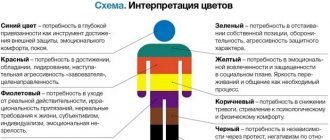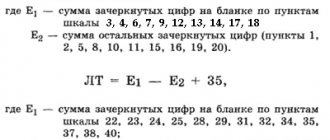Rosenberg Self-Affirmation Scale
Personal self-esteem can change under the influence of various factors. You can check your level of self-esteem using the Rosenberg technique. Indicators on the questionnaire determine whether an individual has depression, excessive anxiety, signs of a leader, and activity in communication.
The subject must indicate his attitude to the given statements on a scale:
- I completely agree;
- agree;
- disagree;
- I absolutely disagree.
The test consists of the following statements:
- I consider myself a worthy person, no worse than others.
- They constantly feel like a failure.
- I have good qualities.
- Able to do something as well as others.
- I have nothing to be proud of.
- I treat myself well.
- Satisfied with his own personality.
- I wish I had more respect for myself.
- Sometimes I feel useless.
- I often think that I am bad at everything.
Points are awarded for each answer. The Rosenberg self-esteem test will show your attitude towards yourself in the form of the sum of points received by the subject.
Difficult period in life
Adolescence is a difficult period in life when a child ceases to be a child, but is not yet an adult. At the same time, society sets its own conditions for him: the teenager does not yet have complete freedom, his will is limited, but he feels like a mature person, capable of making serious decisions, and control begins to burden him. The worldview is changing, he is looking for new guidelines. Maxim Gorky once succinctly expressed himself in his work “Theatrical”: “When I was fifteen years old, I felt very weak, unstable on the ground, everything beneath me seemed to be swaying, falling through...”
These words can describe the feeling of most teenagers during the period of growing up. Their self-esteem is also greatly tested.
It is already more difficult for parents to find a common language with them, because they are reluctant to share their experiences. They are characterized by anxiety, suspiciousness, and exaggeration. It is no longer easy to understand where their behavior is feigned and where real problems begin.
In order to find out the level of self-esteem of adolescents, various methods are used. Let's take a closer look at them.
Dembo-Rubinstein test
A vertical line is drawn on the sheet, indicating a feeling, for example, happiness. The top of the line corresponds to the happiest person, and the bottom to the unhappy one.
Are you ready to stop thinking about your problem and finally move on to real actions that will help you get rid of your problems once and for all? Then perhaps you will be interested in this article .
The subject must draw a line on the line that will indicate his current level. A satisfactory level of development is marked with a circle, and the place corresponding to an objective assessment of capabilities is marked with a cross.
The technique contains a scale of health, mental development, character and happiness.
To make the test more convenient, the height of the line should be 100 mm, and a point is awarded for each mm. First you need to complete the test, and only then read the interpretation of the results, otherwise this will affect the honesty of the answers.
As a result, you can find out the main parameters of self-esteem:
- Height. If the result is 75-100 points, then self-esteem is inflated, and the person is closed to gaining new experience and does not accept his mistakes and the comments of other people. Scores below 50 are obtained by individuals with low self-esteem.
- Level of aspiration. It is marked with a cross on the scale. Real results are 60-90 points. If a higher score is received, then the person assesses his capabilities unrealistically and uncritically. Indicators below 60 points indicate low aspirations and unfavorable personality development.
Normal self-esteem on the scale is above the middle. The ideal indicator is a circle slightly below the top plus, and (x) between them.
“Tree” technique
Studying self-assessment of personality traits using the method of L.P. Ponomarenko is used to assess the success of a child’s adaptation at the beginning of schooling and during the transition to secondary education. This technique is aimed at determining the characteristics of the adaptation process and allows us to identify possible problems of the child.
During testing, children are given a sheet of paper that depicts a tree with little people on it and under it. Having carefully examined the tree and the little men, the subject must circle with a red felt-tip pen the figure with which he associates himself, and with a green felt-tip pen the little man in whose place he would like to be. Moreover, each branch of the tree can be equal to personal achievements and successes. Each person is assigned a number. Interpretation of the results of this method of personality self-assessment is carried out based on what positions the student chooses.
Sonerson test
This method of identifying low self-esteem was proposed by psychologist Marilyn Sonerson.
More than 9,000 people have gotten rid of their psychological problems using this technique.
You can take the test online; the higher the score, the lower your self-esteem:
- 0-7 points indicate an ideal state, independence and autonomy;
- 8-15 points indicate average self-esteem. In this case, a person sometimes worries about his appearance and the opinions of others;
- 16-25 – low self-esteem;
- 26-50 points signal excessively low self-esteem, which causes mental and physical discomfort.
The Sonerson test will help you identify problems with self-confidence and find out at what stage you need the help of a psychologist.
How to deal with a teenager?
Try to understand and accept
Now imagine that you are the parents of a teenager. Due to changes in his behavior, it can be difficult for you. But you still love your child, and you are not indifferent to how he treats himself. You are worried about his emotional state.
Sometimes you are offended that he does not share the details of his life with you, has become secretive, is rude, and brushes it off. He may even have become prone to deviant behavior. But you want to improve the relationship, and you really want your child to trust you.
The first reaction to his behavior is irritation. Maybe you don’t even particularly hold back your emotions or choose your words when expressing your complaints. But remember: the child’s behavior is aimed not only at self-expression, but also at getting you to pay attention to him.
Believe me, he himself really wants everything to be fine with you.
The peculiarity of his worldview is that it seems to him that no one understands him. Therefore, deep down in his soul, he really wants you to understand his throwing and accept him for who he is now. He doesn't talk to you because he's afraid of your reaction. Try to restrain yourself, try to calm down.
Ponomarenko test
Diagnosis of personal problems is carried out using a special form. It shows character traits, a total of 15 positive and the same number of opposite ones.
If you don’t want to give up and are ready to really, and not in words, fight for your full and happy life, you may be interested in this article .
In the middle of the form there are columns numbered from 1 to 7; the choice must be made depending on how pronounced the pair of qualities is:
- The column with number 1 says that the person does not have a drop of anger.
- The seventh column shows a person who is 100% evil.
- The fourth is chosen by people with an average position of kindness and anger.
- The third says that the subject is more kind than evil, and the second says the opposite.
The closer the column is to the right or left side of the properties, the more pronounced they are.
Testing consists of several stages:
- First, select the column number, indicating it with a cross.
- Return to the first pair of characteristics and indicate the desired properties with a circle.
- Finally, the results are processed. In each pair, the position of the real state and the desired state is considered.
At the final stage, the difference in the positions of all 15 digits is summed up and the results are compared with the key.
If a problem is discovered, the person considers himself worthless, insignificant, and often speaks self-deprecatingly. It is also difficult for him to accept compliments, refuse another person, and defend his opinion. This condition is inherent in asthenics.
The reasons for low self-esteem are hidden in childhood, when the child is scolded for the slightest offense, reacts to him aggressively and irritably, and is not supported. A problem can also arise in an adult due to unpleasant events in life, for example, dismissal from work or financial insolvency.
The type of temperament also influences your attitude towards yourself. Sanguine and phlegmatic people usually have a stable psychological state, while for choleric people it constantly fluctuates. Melancholic people always have low self-esteem. Therefore, they need to develop confidence.
“A selection of methods for diagnosing self-esteem of a personality of primary school age”
DIAGNOSTICS OF PERSONALITY SELF-ASSESSMENT
Pedagogical diagnostics is an integral component of pedagogical activity, because the implementation of training and education processes requires assessment, analysis and accounting of the results of these processes. Pedagogical diagnostics is aimed at solving problems of optimizing the educational process, differentiating students, as well as improving educational programs and methods of pedagogical influence.
Self-esteem of the personality of a junior schoolchild is an object of study for many psychologists.
Among the various methods for measuring self-esteem in children, this work includes those that are most adequate for working with children of primary school age.
- Dembo-Rubinstein scales
To identify different levels of moral judgments and self-esteem that are formed in younger schoolchildren in the process of educational activities, a special ascertaining experiment was conducted. When studying the levels of self-esteem formation among third-graders, the methodology of mutual and self-assessment was used. Based on the Dembo-Rubinstein rating scale (S.Ya. Rubinstein, 1970), the instrumental part of the methodology was developed: a three-color scale consisting of red, green and black parts, indicating strong, medium and weak expression (or absence) of any personal quality. The children were asked to mark their position and the position of their classmates on this scale. Thus, they had the opportunity to give themselves and their comrades high, average and low ratings regarding ten qualities selected by the experimenter that characterize the moral sphere of a person (kindness, honesty, justice), features of activity associated with the humanistic and social orientation of the individual (helping comrades, working for class), emotional and volitional manifestations (cheerfulness, courage), as well as rational and business characteristics (smart, good student). To determine how children perceive the level of their position and the position of their friends in the class, they were asked to give an assessment on such an indicator as “respected in the class.” The methodology for ranking qualities was aimed at determining the values of children's orientation. With its help, one could see in what order children identify the listed qualities in a person. The methodology for determining human qualities made it possible to find out the levels of representation of the essence of these qualities in children’s judgments, i.e. how clearly children understand the essence of the qualities that were presented to them for assessment and ranking. Children's definitions were assessed according to three criteria: the presence of qualities, adequacy and degree of generalization. As a result, four levels of definitions of these qualities were identified (absent, inadequate, adequately situational and adequately generalized), which were given appropriate scores for subsequent quantitative data processing (0, 1, 2, 3).
- De Greefe test
This experimental procedure, proposed by the French psychiatrist De Greefe, is a simple and very ingenious technique for determining self-esteem.
It is recommended to use it when working with schoolchildren in grades 1-2. Purpose of the study:
determine the nature of the child’s self-esteem.
Material and equipment:
sheet of paper, pen or pencil.
Research procedure
In an individual conversation, the child is shown three identical circles drawn on a piece of paper and told: “There are three circles in front of you: the first circle represents your teacher, the second – you, the third – your classmate (name). From each circle you need to lower a line down. The longest line should be drawn from the one who is the smartest among you; from the one who is the stupidest - the shortest; from the one who is average - average." After completing this task, the child is asked to explain his decision.
Processing and analysis of results
De Greefe's experiments revealed increased self-esteem in children with mental retardation. These children tended to draw the longest line from the circle representing themselves. The symptom of increased self-esteem discovered by De Greefe in mentally retarded children L.S. Vygotsky suggested naming the methodology after the author. The occurrence of this symptom in children with reduced intelligence is explained by the inherent high emotional coloring of their assessments and self-esteem, which is due to the general immaturity of the individual.
According to A.I. Lipkina (1976), normally, already in the first grade, all children draw the longest line from the circle that represents their teacher. When deciding who should get the middle line and who should have the shortest line - the subject or his classmate - advantage, as a rule, is given to the one who studies better.
If a child's results differ from this most common assessment option, one should not jump to conclusions about the child's mental disability. This examination, like any other, must necessarily be accompanied by a conversation with the child, during which the reasons for his actions and decisions are clarified.
During primary school age, a certain dynamics of self-esteem is observed. First- and second-graders (especially low-achieving and excellent students) reveal a clear desire to somewhat overestimate themselves: weak students, as the subsequent conversation shows, because of their disagreement with being included in “third-rate” students, excellent students - out of fear that, to some extent, their position in the class, which they value very much, will be shaken. These children, drawing a longer line from their circle, very openly declared to the experimenter that they were better than others, that others were worse students.
In the 3rd and especially in the 4th grade, the tendency to overestimate oneself among lagging students is significantly reduced, and among excellent students it is not expressed in such an overt form. Under the influence of the already learned ethical norm of “praising oneself immodestly,” excellent and well-performing fourth-graders, as a rule, no longer dare to draw a longer line from their circle than from a friend’s circle, even when they have a clear superiority over him in academic performance. Unconditionally drawing the longest line from the circle denoting the teacher, they then declare: “I can’t say which of us is smarter, me or N., ask the teacher.”
Thus, according to the fair remark of A.I. Lipkina, by the end of primary school age, the method of directly obtaining self-esteem loses its diagnostic value.
- “Ladder” technique
This technique was developed by V.G. Shchur is intended to identify the child’s system of ideas about how he evaluates himself, how, in his opinion, other people evaluate him, and how these ideas relate to each other.
Purpose of the study:
determine the characteristics of the child’s self-esteem (as a general attitude towards himself) and the child’s ideas about how other people evaluate him.
Material and equipment:
a wooden (or painted) ladder, a figurine of a man, a sheet of paper, a pencil (pen).
Research procedure
The technique is carried out individually. The research procedure consists of a conversation with a child using a certain rating scale on which he places himself and presumably determines the place where other people will place him.
A conversation with a child begins with a casual conversation about the composition of his family, his close relatives, friends, etc. Then the experimenter shows a wooden ladder, on which three steps go up and three down from the central platform. (In a modified version of the technique, a similar ladder is drawn by the experimenter on a sheet of paper). In this case, the child is given instructions:
“Look at this ladder. If you seat all the children on it, then at the very top step there will be the best children, below - simply good, then - average, but still good children. Bad children are also distributed accordingly, i.e. at the lowest rung - the worst, etc.” After this, the child is given a figurine of a man (figurines of a boy or a girl can be used, depending on the gender of the child). The experimenter asks to place this figure on the step that the child himself, in his opinion, corresponds to: “Where will you put yourself?” In this case, it is necessary to find out why the child chose this particular step. Then the child is asked to place the figurine on the step where, in his opinion, his mother, as well as other close adults, will put him: “What step do you think your mother will put you on? Why do you think so?" Further, depending on the composition of the family and significant environment, approximately the following questions are asked: “Where will your father, grandmother, grandfather, brother, sister, friend, teacher put you? Where will mom and dad put their brother or sister?” In all cases, the psychologist asks the child to explain his choice.
The child is also asked about who will put him on the top step (especially if for some reason he thinks that his mother will not put him there), and who will put him on the bottom step. In addition to these basic questions, a detailed conversation is held with the child about why he thinks this way and not otherwise, and what kind of relationships he has with different people.
As the child answers, the psychologist records the named positions (in the version of a drawn ladder, this can be done directly on its steps).
A conversation with one child takes approximately 20-30 minutes.
Processing and analysis of results
Children of senior preschool and primary school age show great interest in their relationships with other people and, as a rule, readily participate in a conversation on this topic.
When assessing the results, it is necessary first of all to establish the child’s attitude towards himself. In older preschool and primary school age, the vast majority of children consider themselves “good” and place themselves on the top steps of the ladder. At the same time, as data from V.G. Shchur, children who put themselves at the very top level (i.e., who count themselves among the best) are almost never able to justify such self-esteem. Children who did not consider themselves the best approached assessing themselves more objectively and critically and explained their choice with various reasons, for example: “I still play around sometimes,” “I ask a lot of questions,” etc.
As a rule, the attitude of other people towards a child is perceived by him in a rather differentiated way: children believe that close adults (mother, father, grandfather, grandmother, and teacher) treat them differently.
The most important thing for understanding a child’s self-esteem is the ratio of assessments “for himself” and “for his mother.” The safest option is when children believe that their mother will put them at the very top of the ladder, and place themselves a little lower - on the second or third step from the top. Such children, feeling strong support from the most significant adults, are already developing the ability to take a rather critical approach to assessing themselves as individuals. The author of the methodology calls them “the most prosperous”.
Another option is that the child’s high opinion of himself coincides with the opinion of the mother. This situation may be typical for children:
- truly prosperous;
- infantile (all ratings are placed at the highest level,
but there are no substantiated, detailed formulations explaining such attribution);
- “compensating” (wishful thinking).
And another option is that children put themselves higher than they believe their mother would put. The author of the methodology considers this situation unfavorable for the development of the child’s personality, since the discrepancy in assessments is noticed by the child and carries a terrible meaning for him - he is not loved. According to V.G. Shchur, the low assessment predicted by the child from the mother in many cases is associated with the presence of younger children in the family, who, according to the subjects, will be placed by the mother at the very top step.
At the same time, it is extremely important for such children that their position on the top step is supported by one of the adults. In this situation, it is advisable to ask the question: “Which of your loved ones will still put you on the top step?” And, as a rule, every child has one of the people around him for whom he is “the best.” Most often this is dad or grandparents, even if the child meets them quite rarely.
If children do not expect a high rating from any of their close adults, they say that a friend or girlfriend will put them at the highest level.
For younger schoolchildren, it is also important to find out the teacher’s predicted assessment of the child and analyze the child’s explanations about this.
- “Draw yourself” technique
This technique was developed by A.M. Prikhozhan and Z. Vasiliauskaite and is intended for diagnosing the emotional and value attitude towards oneself in children 5-9 years old.
Purpose of the study:
to determine the characteristics of the emotional-value attitude towards oneself in children of senior preschool and primary school age.
Material and equipment.
To complete the task, the child is given six colored pencils - blue, red, yellow, green, black, brown. It is advisable to use Polycolor pencils in order to mitigate as much as possible the factor of individual preference and the influence of color. The method form is a standard sheet of unlined white paper folded in half (like a book). The first page of the book remains blank. Here, after the work is completed, the necessary information about the child is recorded. On the second, third and fourth pages of the book, placed vertically in front of the child, the name of each drawing that the child has to complete is written at the top in large letters, respectively: “Bad boy/girl (depending on the gender of the child), “Good boy/girl”, “ I".
Research procedure
The technique can be carried out both frontally and individually.
Instructions for completing the task are given before each drawing, so
with frontal execution, children move on to the next drawing only after everyone has completed the previous one.
Instructions:
“Now you will draw. First, draw a bad boy or a bad girl. You will draw with three pencils. Choose these pencils and show them to me, and put away the remaining three. (Make sure all children do this.) Find the page that says "Bad Boy/Girl" at the top. Did you find everything? (Check if all children have found the right page). Let's start drawing."
After all the children have finished drawing, the following instructions are given: “Now put down the pencils you used to draw and take the remaining three. Show them to me. (Make sure that all children understand and follow these instructions correctly.) With these pencils you will draw a good boy or a good girl. Find the page that says “Good Boy (Girl)” at the top. Did you find everything? (Check.) Let’s start drawing.”
Instructions given before the third drawing: “On the remaining piece of paper (on which “I” is written at the top) each of you will draw yourself.
You can draw yourself with all six pencils. Take all the pencils in your hand and show me. (Check.) Now pay attention! Let your drawing have a secret. If someone wants to draw themselves like a good boy or a good girl, then let the drawing have more of the colors with which you painted the good boy or girl. And if you want to draw yourself as looking like a bad person, then it will contain more of the colors that were used to paint a bad boy or girl. But try to use all the pencils in this drawing. (After this, you should briefly repeat the instructions and answer the children’s questions). So, find the page that says “I” (check) at the top and start working.
It is necessary to specifically monitor how children follow each instruction and answer all questions before they start drawing.
Children work independently. An adult intervenes only if instructions are violated. Valuable additional information is provided by observing children’s behavior while performing tasks, recording too fast or too slow performance. When performed frontally, it takes about a lesson to complete the entire technique.
Individual implementation usually requires less time (on average about 3 minutes). In general, this type of work is preferable, since it allows you to record the order of drawing, including the sequence of using colors, the child’s spontaneous statements, his facial expressions, gestures, and the time he spends on each of the drawings. In addition, the experimenter can talk with the child immediately after he has completed the task.
After completing all the work, a conversation is held with the child, which contains questions about which drawing did you like to draw the most, and which one did you like the least and why? Which drawing, according to the child, turned out best, and which one turned out worse? Why is the boy (girl) bad in one picture, and good in the other? What can you tell us about each of them? Who - good or bad boy / girl - does he like best? Who would he choose as his friend? Why? (Particular attention should be paid to cases where the subject prefers a bad child.) How did the child want to draw himself? What can he tell you about himself? What does he like most about himself? What would he like to change about himself? What does he do best? What can’t he do? What would you like to learn? Does he think he can learn it? What does this require? Etc. Here is only an approximate list of questions, which the experimenter can supplement and change depending on the specific case.
It is advisable to conduct a similar conversation in cases where the technique was presented frontally, but since this happens with a certain delay, it is necessary before the conversation to show the child his work and record those cases when he expresses a desire to change something in the drawings, and his story about these changes. Moreover, it is the child’s own desire that is important. The psychologist should not ask him if he wants to change something in his drawing, or in any other way lead him to this idea. If the child wants to draw other drawings (one or all three), he should be given this opportunity.
Processing and analysis of results
The diagnostic use of drawing tests, especially when they involve (as in this case) the human figure, involves three main levels of analysis.
First level
– manifestation in the drawing of indicators of organic damage to the central nervous system (inclination of the figure is more than 95 or less than 85 degrees, double and/or broken lines, “shaking” lines (trembling), not connected lines (I. Shvantsara et al., 1978). If such signs are detected, then the interpretation of the figures at subsequent stages of analysis should be approached with extreme caution.
Second level
involves analysis from the point of view of compliance with age standards.
In the case of a sharp difference between the drawing and the general age norm, it is necessary to find out whether the omission, for example, of individual details of a human face or figure is associated with a developmental delay (which makes it possible to obtain valuable diagnostic data on the general development of the child) or is it associated with certain problems, fears, conflicts . For example, the absence of hands may indicate both insufficient development and a low level of contact, impairments in communication. If we are talking about a developmental delay, then the transition to the third level
of interpretation - the projective one - should be carried out with extreme caution. A number of authors believe that if, at the first and second levels, indicators are obtained that indicate organic lesions of the central nervous system or a significant developmental delay, one should not move to the third level at all. However, the practice of the authors of the methodology shows that even such children project their own feelings, attitudes, and motives in their drawings. Therefore, here, too, a third-level analysis can be applied, but this should be done with extreme caution, taking into account only the most pronounced signs and paying special attention to whether the appearance of a particular indicator is associated, for example, with general underdevelopment.
The projective interpretation of individual indicators, both substantive and formal, is widely presented in special practical guides (see, for example: E.S. Romanova, O.F. Potemkina, 1991; R. Belyauskaite, 1994). Particularly noteworthy is the analysis of formal indicators using the example of the drawing “Non-existent animal” presented by M.Z. Dukarevich (1989). In this regard, the projective indicators and symbolic meanings of various aspects of the drawing will not be discussed in detail here.
General scheme for interpreting the results of the technique.
When interpreting data, both projective criteria and indicators based on the direct scaling method are used.
1. Analysis of the “self-portrait” (drawing “I”): the presence of all the main details, the completeness of the image, the number of additional details, the thoroughness of their drawing, the degree of decoration of the “self-portrait”; the static nature of the drawing or the representation of the figure in motion, the inclusion of oneself in any plot - a game, dance, walk, etc. It is known that the presence of additional details - detailed drawing, “coloring” - indicate a positive attitude towards the character being drawn. On the contrary, the incompleteness of the drawing, the lack of necessary details indicate a negative or conflicting attitude, as discussed above. An image in motion, inclusion in a plot - for an active, creative attitude to reality.
2. Analysis of other projective indicators for “self-portrait”, including the size of the picture, its location on the sheet (the so-called projective semantics of space), the relationship between individual parts of the picture, etc. It is known, for example, that placing a picture at the bottom of the page can indicate that the child is depressed and has an inferiority complex. The most unfavorable is the “self-portrait”, drawn in profile and located in the lower corner of the page, especially in the left.
3. Comparison of the child’s “self-portrait” with the drawings of a “good” and “bad” peer according to the following parameters:
a) the colors used in the “self-portrait”, their correspondence to the colors of the “good” and “bad” child, which colors are greater;
b) the size of the “self-portrait” compared to the sizes of the other two drawings;
c) repetition in the “self-portrait” of details from the drawings of the “good” and “bad” child: clothes, headdress, toy, flower, slingshot, pistol, etc.;
d) the presence of new details in the “self-portrait” and their nature;
e) general impression of the similarity of the “self-portrait” to the drawing of a “good” or “bad” peer.
Analysis of amendments, crossing out, redrawing (without significantly improving the quality of the drawing); their severity indicates conflict and anxiety in the child.
Analysis of the drawing process, technical features of the drawing, and when carried out individually - the nature of spontaneous statements, the order of depiction of individual details and the time spent on a particular drawing. Particular attention is paid to cases and motivations for refusing to complete a particular drawing or task in general. The authors of the method give an example when an 8-year-old boy, with a pronounced discomfort of success, refused to draw a “good” peer, citing the fact that he does not know how to draw “good”, he never succeeds in anything “good”.
It is advisable to make a final conclusion about the peculiarities of the child’s emotional and value-based attitude towards himself only on the basis of a comparison of the qualitative characteristics of the drawing and the data of the conversation. At the same time, it is important to keep in mind that we are not talking about verifying the criteria for assessing a drawing based on the conversation data, but rather about taking into account both groups of data in the final conclusion of the psychologist.
- Methodology “Three assessments” A.I. Lipkina
Purpose of the study:
identify the student’s emerging evaluative position.
Research procedure
To implement the methodology, students are asked to complete any educational task in writing. Students’ work must be assessed in three grades: adequate, overestimated, underestimated. Before handing out notebooks, students are told: “Three teachers from different schools checked your work. Each had a different opinion about the completed task and therefore they gave different marks. Circle the mark with which you agree.” Then, in a conversation with students, the answers to the following questions are clarified:
1. Your work deserves an o, and the teacher gave you an “five.” Will you be happy about this or will it upset you?
2. Which marks make you happy and which ones make you sad?
3. What kind of student do you consider yourself: average, weak or strong?
Processing and analysis of results
The level of self-esteem of schoolchildren is determined on the basis of the data obtained from the following results:
the coincidence or discrepancy of self-esteem with an adequate assessment of the teacher, the nature of the argumentation of self-esteem: a) argumentation aimed at the quality of the work performed, b) any other argumentation, c) stability or instability of self-esteem, which is judged by the degree of coincidence of the nature of the mark given by the student to himself and the answers to the questions asked.
6. Study of the level of aspirations
Purpose of the study:
to identify self-esteem and the dynamics of the level of aspirations of students in an experimental situation.
The level of aspiration is a variant of F. Hoppe's methodological technique. The subject is offered a number of tasks (from 14 to 18), differing in degree of difficulty. All tasks are written on cards, which are located in front of the test subject in ascending order of their numbers. The degree of difficulty of the task corresponds to the size of the serial number of the card.
Studies conducted using this technique (F. Hoppe, M. Yuknat, M. Neimark, T. Bezhanishvili, B. Serebryakova) showed that, as a rule, subjects choose more difficult tasks after successful solutions, and, conversely, after a number of unsuccessful decisions turn to easier tasks. The quality of the first task affects the choice of the next one.
Methodology
Experimental material
The proposed tasks can be very different in content depending on the educational level of the subjects.
To conduct the experiment, you need to prepare cards measuring 12x7 cm, on which the numbers from 1 to 14 are clearly marked, and a stopwatch.
Experiment procedure
The cards are laid out in two rows. After presenting the instructions, the subject is asked to choose a task. After completing each subsequent task, the experimenter asks the subject each time: “Now take the task of whatever difficulty you want.” The experimenter records the time taken to solve the problem and after each task says: “You completed this task on time. I’ll give you a plus” or “You didn’t meet the deadline. I’m giving you a minus.”
Instructions to the subject
In front of you are cards with tasks written on the back. The numbers on the cards indicate the degree of difficulty of the tasks. The tasks are arranged in increasing difficulty. A certain time is allotted for solving each task, which you do not know. I'm keeping an eye on him with a stopwatch. If you do not complete the task within the allotted time, I will consider the task not completed. You must choose your assignments yourself. Thus, the subject is given the right to choose the difficulty of the task himself. The experimenter can, at his discretion, increase or decrease the time allotted for completing the task, thereby arbitrarily causing the subject to experience failure or success.
Processing the results
The obtained data is entered into a pre-prepared protocol (see appendix). The experimental data can also be depicted in the form of a curve: the serial numbers of the sample (selection of the next task) are plotted on the abscissa axis, and the selected card numbers are plotted on the ordinate axis. The sign (+) marks successfully completed tasks, the sign (-) marks unsuccessfully completed ones (see figure).
The experimenter records in detail all the statements of the subject, his reactions, as well as his own comments.
After the experiment is completed, you should ask the subject the question: “What guided you when choosing the task?”
18
Gorbatov test
Low self-esteem of a woman or man requires treatment. They try to increase confidence through training and sessions with a psychologist.
Violations can be recognized using the Gorbatov test. It is based on ideas about personality traits. These qualities are taken into account during education.
A task consisting of several stages will help you understand your own ideas about the ideal:
- The sheet is divided into 4 parts and each is signed with Roman numerals. The subject receives 4 sets of positive character traits and in each set he must highlight the most valuable and significant ones. They are written out in a column along with the number. In this way, all qualities are processed.
- At the second stage, they carefully consider the written qualities and find those that they possess in reality. They are circled.
After this, the result is calculated: the real qualities are divided by the number of ideal ones and multiplied by 100%. If the result is 0-10 points for men and 0-15 for women, then self-esteem is inadequately low. The higher the result, the less self-doubt.
More than 9,000 people have gotten rid of their psychological problems using this technique.
How to pass this test?
Before you are 48 words, personality traits. Out of 48, you must choose only 20, those that characterize your ideal personality. The very ideal you strive for. This ideal, at your discretion, can include both positive and negative qualities.
These are 48 words. Frivolity, pedantry, sensitivity, thoughtfulness, hot temper, melancholy, vanity, love of life, rancor, feelings of envy, caring, excessive modesty, sincerity, touchiness.
Prudence, charm, responsiveness, desire for accuracy, integrity, contempt, energy, romance, suspicion, hospitality, determination, swagger, rationality, sophistication, capriciousness, lethargy.
Trust, suspiciousness, perseverance, lack of restraint, without complexes, tenderness, indecisiveness, nervousness, vindictiveness, shyness, restraint, sympathy, self-forgetfulness, stubbornness, compliance, enthusiasm, cowardice, endurance, coldness, enthusiasm.
Now build a table. The table consists of five columns. The name of the first column is d1, the rank number of the standard, i.e. How important is it, ideally, for you to have this or that quality? The second column (quality itself) will contain the 20 selected qualities of your ideal personality. In the third column - d2 the rank number of your real personality to what extent this or that quality is actually characteristic of you. The last two columns will be the result of the first three
The table will look like this with approximate filling:
Kazantseva's test
The provisions are read to the subject, and he must write down three possible answers: “yes”, “no”, “I don’t know”. Choose the option that best matches the behavior. Answers are given quickly, without hesitation.
Examples:
- I always expect success.
- No self-confidence.
- In terms of abilities and resourcefulness, I do not lag behind those around me.
- Periodically they feel useless.
- It seems like I can't achieve anything.
- I often do things that I regret.
- I don't worry about possible failures.
- Various obstacles always prevent me from successfully completing assignments.
- I think that someone always needs me.
- I think I do worse than others.
- I'm usually lucky.
You can find out your own level of self-esteem after calculating the results. First, they count how many affirmative answers there are with odd numbers, and then with even numbers. The second number is subtracted from the first number. The result can range from -10 to +10. If the score is from -10 to -4, then self-esteem is low, and from -3 to +3 - average. Individuals with a high level of self-confidence receive more values.
Why should everyone get tested?
The technique was developed by the famous Soviet psychologist Sergei Andreevich Budassi in the 1970s. Even today, the Budassi test is successfully used by psychologists all over the world.
Analysis helps to determine the “I-concept”, the average value of the “Real-I” and the “Ideal-I”. It is the “I-concept” that influences the choice of a person’s type of behavior, which, in turn, determines the direction of activity, actions and communications.
Why is it important to understand your self-concept? Not everything we think about ourselves is 100% real. Some aspects of our personality are not perceived by consciousness and are realized by us unconsciously. The Budassi test allows us to determine the level of our self-esteem, and, based on this knowledge, adjust our actions and decisions.
Adapted version of Eysenck's technique
To identify deviations in the perception of one’s own personality, a technique is used that contains a description of various mental states. If a person feels this often, he gives 2 points, occasionally - 1, never - 0.
First group:
- I feel insecure.
- I blush over trifles.
- I sleep restlessly.
- I get discouraged easily.
- I'm worried about possible troubles.
- I'm afraid of difficulties.
- I constantly dig into the shortcomings.
- I'm easily convinced.
- Suspicious.
- I can't bear the wait.
Second group:
- Often even a simple situation seems hopeless.
- I get discouraged because of troubles.
- I blame myself for big failures.
- I don't learn from misfortunes.
- I refuse to fight, considering it useless.
- I feel helpless.
- I often despair.
- Confused by difficulties.
- In difficult moments, I behave like a child in order to gain pity.
- I believe that my shortcomings cannot be overcome.
Third group:
- The last word is always mine.
- I often interrupt my interlocutors.
- I get angry easily.
- I make comments to others.
- I'm trying to be an authority figure.
- I'm not content with little.
- I can't control my anger well.
- I prefer control to submission.
- I gesture sharply and rudely.
- Revengeful.
Fourth group:
- It's hard to change habits.
- It's difficult to switch attention.
- I am wary of innovations.
- It's hard to convince.
- I suffer from obsessive thoughts.
- It's difficult to get close to people.
- I get upset, even if plans are slightly disrupted.
- Often stubborn.
- I rarely take risks.
- I often deviate from my daily routine.
The results can be determined after calculating the sum of points.
Similar techniques are often used to study student self-esteem. This allows them to form an image of themselves, correct uncertainty, and learn to correctly assess their own personality.
Distortion of self-esteem arises as a result of discrepancies between aspirations and actual achievements. The greater the claims, the more success a person must achieve in order to satisfy them.
Test “Self-assessment of mental states” (according to Eysenck)
According to Eysenck, a number of statements are proposed that describe states. Using a self-assessment sheet, a person gives 2 points if he often experiences this condition, 1 point - rarely, and 0 points if he does not have this condition. For example, these are the following lines with statements:
- I don’t feel confident in myself;
- I often blush over little things;
- I sleep restlessly.
In total, 4 groups of 10 phrases are given with a brief description of the states.
Scoring and interpretation of scores
At the end of the test, the results are processed by counting them.
- 1 group of phrases by state tests anxiety;
- from 11 to 20 question - frustration (a state manifested in failure, futile expectation, etc.);
- Group 3 - aggressiveness;
- 4 - rigidity (hardness, inability to change or react to situations).
Further, the method of diagnosing self-esteem consists in assigning the calculated points for each category of phrases to small, medium and significant manifestations of anxiety (or aggressiveness, as well as rigidity and frustration). So, in category 1, a value from 0 to 7 points is interpreted as low anxiety, up to 14 points - average, and from 15 to 20 an overly anxious person receives.
Description of states (Eysenck)
Based on the test results, self-assessment of mental states can show the norm in all categories or a deviation from it. Further, for example, if there is increased rigidity, a recommendation is given not to change your place of work or personal life. A person with aggression is assessed as having communication difficulties.
Leary test
The method allows you to explore a person’s idea of his own personality. Each of them needs to be assessed as follows: if the definition corresponds to ideas about oneself, a plus is placed opposite it, and if not, a minus. You must answer questions sincerely.
Upon completion, points are calculated using the key to the questionnaire (the difference between ideas about a person and the desired image is important). The maximum result is 16 points.
Types of personal characteristics identified during testing:
- Authoritarian. If a person scores from 13 to 16 points, then he is distinguished by authority, increased despoticism, and is a leader in all types of activities. They love to teach others and do not take advice from others. From 9 to 12 points are scored by energetic, competent people who demand respect for themselves. 0-8 points indicate a self-confident person, but he will not necessarily be a leader.
- Selfish. 13-16 shows the desire to be above others, prudence and independence. Such a person likes to shift responsibility to others and is boastful and arrogant. From 0 to 12 for people with egoistic traits and a tendency to compete.
- Aggressive. 13-16 points indicate a person’s harshness and hostility towards others. This often leads to antisocial behavior. 9-12 means that a person is frank and strictly evaluates others, often mocks and criticizes. 0-8 points indicate stubbornness, perseverance, perseverance and energy.
- Suspicious. 13-16 points are scored by individuals with a schizoid character type, who have an aloof attitude towards the world, doubt everything and are always dissatisfied. 9-12 points indicate difficulties in contacts with people due to uncertainty, fear of the bad attitude of others, secrecy and isolation. 0-8 speaks of being critical of yourself and the entire world around you.
- Subordinate. 13-16 points are scored by people who are submissive and prone to low self-esteem. They always give in to others, and put themselves in last place, feel guilty for any reason, are passive and try to find support for themselves. 9-12 – the subject is shy and timid, has a predisposition to subordination, always follows the orders of others and does not have an opinion.
- Dependent. 13-16 indicates self-doubt, anxiety, dependence on other people's opinions. 9-12 points are scored by obedient, fearful and helpless individuals who are unable to resist. 0-8 – a person is distinguished by his gentle character and gullibility, often admires others.
- Friendly. 9-16 – the individual strives to gain social approval and be good to everyone. 0-8 – often compromises in conflict situations, follows all rules and conventions, wants to be the center of attention. Warm and friendly in his relationships with others.
- Altruistic. Hyper-responsible people score 9-16 points. They always sacrifice their interests, impose help and are overly active. But this is only a mask that hides the opposite type. 0-8 points indicate selflessness and emotional attitude towards others. This is a kind person who always encourages and calms in a difficult situation.
The first four results are obtained by people who are accustomed to defending their opinions and occupying leading positions. The other four options paint the opposite picture.
Tests to determine self-esteem are also administered to adolescents. This period is considered the optimal phase for working with self-esteem. This is associated with the formation of a full-fledged self-awareness. Parents should provide the opportunity to talk openly about exciting topics and conduct dialogue on equal terms, supporting the teenager in solving problems.
At the age of 9-12 years, aggression and parental rejection, combined with low self-esteem, can lead to serious disturbances in personality formation.
At a young age, self-esteem is based on the opinions of others. It is installed without critical analysis. This influence is very significant.
Processing the results
Processing is carried out on six scales (the first, training - “health” - is not taken into account). Each answer is expressed in points. As noted earlier, the dimensions of each scale are 100 mm, according to which the students’ answers receive a quantitative description (for example, 54 mm = 54 points).
1. For each of the six scales, determine:
a) level of claims - the distance in mm from the bottom point of the scale (“O”) to the “x” sign;
b) the height of self-esteem - from “0” to the “x” sign;
c) the value of the discrepancy between the level of aspirations and self-esteem - the distance from the “x” sign to the “-” sign; if the level of aspirations is lower than self-esteem, it is expressed as a negative number.
2. Calculate the average value of each indicator on all six scales.











